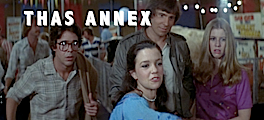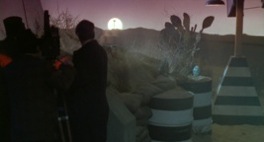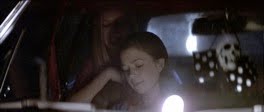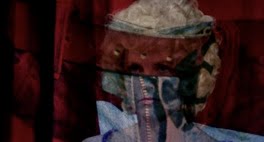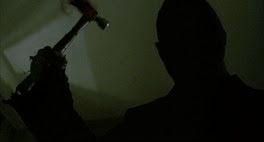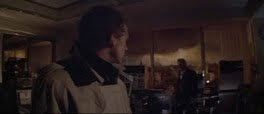From Tobe Hooper's Masters of Horror: 'Dance of the Dead.'
An overly-spastic and lacking-in-pretension piece of CW Network-ready drama, fittingly divined - not without its difficulties and typical Hooperian lapses of judgment - into something passionate and indelible by Hooper's inspired (inspired by the televisual format, by Mick Garris, by his handpicked Matheson-son-scripted teleplay's making kissing cousins of wild, hedonistic youth for the purposes of a sexagenarian filmmaker, take your pick) dive into incessantly aestheticized, overly photographed, visceral and so resolutely accessible - thoroughly youthful a sort of cinematic style - modern cinematic impressionism, in which a mundane, destitute future becomes his Parisian landscape from which to evoke, via brush strokes and painted light, the pathos of our present, present lives, and present circumstances - the world, its natural lighting, and the quotidian atmosphere, whether the everyday pastoralism or even the everyday pollution. Perhaps Dance of the Dead is a return for him to the manner of his Texas Chain Saw-and-prior years (of his cinema verité work and Eggshells work). Texas Chain Saw Massacre also lunges for the visceral sensitivity of throats with the implementation of unceasing aesthetic searching, less careful cinematic sentences and more bare expressionism, slightly-more-coherent Action painting. That was before he'd fall into the careful Mannerism, compositional nicety, and increasingly sparest of coverage from Eaten Alive on.
Dance of the Dead is Hooper's airing out his concern of today's youth - given, an old fogey's sort of conception of developing youthful nihilism: a grab bag of tropes of death-rock leisure time, amped up to a degree of 11 in sex and violence (lots of humping and puffed-out chests), but which only to someone without further production means automatically points to the worst of humanity. At least these hooligans are taking in some culture at all! But perhaps that's another salient point of Dance of the Dead (the Matheson, Sr. story which I have not read): that the dancing corpses, a new, terrible, but still "artistic" intake for the ruined, violent, but still aesthetically-searching, sensitive youth of our post-apocalypse, are the culture of a world that has already destroyed itself. If art is the symptom of humans' most driving impulse for self-extinguishing ("the art impulse is the death impulse," whoever said that), then Hooper's devotion to telling effectively this story of art persisting at an existential tipping point, representing the sensitive people's cultivated nihilism and hatred instead of their cultivated compassion (as we'd like to think of art now, when not pushed by the commercial winds of things, at least), then Dance of the Dead is a fitting tribute to the man - made by the man - whose career was always an attempt (after Texas Chain Saw Massacre set the pulse for it pretty much unsparingly - horror and little else) to unite horror with art, and the nexus of that hopeful combo with the need to show the world as the most self-defeating of things (TCM, Eaten Alive, and The Funhouse prime horror texts that partner with the aim to reveal all that is wrong with the world... Spontaneous Combustion the non-horror coming out of Hooper's art, worldly outrage, and self-extinguishment instinct).
Hooper's depth of emotions and fine skills of observance in regards to character, performance, and undercurrents of drama miraculously make this awkward tale work, while strongly underlying all the film's riper elements - like its caricaturing eye of punk culture and the sub-Chandleresque, quasi-noir dialogue young Matheson tries his hand at - is a subtler dramaturgy involving the failing of the younger generations by the incrementally destructive generations of the past (superbly embodied, reductio ad minimum, the mother character, representing the older world, one that has simply led to further terrorism and world wars, simply through the story of a mother who gave up on a wayward daughter too easily and too self-interestedly).
So no question to the symbolic worthiness of pies, standing in as the preferable adjoining point between the wholesome but perfidious past (our present), and the anarchic but persisting future. They represent the young female protagonist of the episode, Peggy - perhaps off-handedly in the salacious way, as she only makes comment of their freshness, how they were "made by mother," and that she and the strapping young goth lad bonded over his interest in them - but mostly in the manner in which they exist as a material remnant of the way things were (back when we could buy and want things), and they prefigure the manner in which Peggy exists: she is also a remnant of a more wholesome time, but stripped of the corruptible "worth" of being a part of a chugging engine of money, manufacture, and power, those markers of functioning society. She is, in fact, better than pies, as she is a human being who can change the world through only her moral character, emotional presence, etc. - while pies are pies and, while delicious, would not stack up as conduits of change. (As they do not have souls.)
Anyway, no wonder does the camera linger on the pies in this shot (whom are being sold heavily in the scene just prior to the introduction of this shot), then phases them out (via elegant focus play) to take in the entrance of the true protagonist of the story, the girl Peggy. She was the one selling them so energetically in the prior scene mentioned, and Hooper's camera so assiduously tells her now (with this shot) that: you're the pies! The pies are you. They must share the frame with you, who are the center of the frame. You were selling yourself, not the pies, to that young man you were making eye contact with and recommending the pies to just previously. Again, only semi in the salacious way, you are the pie! And the agent of spiritual change in this story. Pies would sort of do that enactment of spiritual change - the shameless young hooligans only want "big fat pieces of meat," but the sensitive hooligan adds in pies around the house as well, as a symbolic gesture - but Peggy would do it better.
And so they, the pies, do share the frame with Peggy, pushed off to the side after the pointed rack focus. They share the frame, as something of an hilarious detail to a scene that plays between Peggy and the sensitive hooligan, who exits from a shitter promptly and anachronistically labeled "GENTLEMEN," then proceeds to obliterate the pies almost entirely from the shot with a replacing of his body in a shared movement with the camera.
The pies obviously vie for the attention of the camera, but it resolutely revolves around her and only her, even as it inches back in the dessert's direction:
A love triangle? The pies peak in at the right of the frame but are clearly misplaced (in a box labeled "forgotten") in the affections of the self-confessed hungry adolescent.
Goodbye pies!
A fun post on what is mostly a fortuitous set detail. But then we can talk about another of Hooper's women-centric films (referring to this film). Peggy is yet another Hooper ingenue. His females are perhaps too innocent and unknowing for him to be called a feminist, or a woman's filmmaker, and his concerns too gender-ambivalent, but his interest in the "woman's picture" (if not the textbook sense of it) is a perhaps incidental (he does not go out "searching" for women-concerned films) but nonetheless intriguing persistence. I feel the uniqueness in which Hooper exists in the genre world of his peers manifests so strongly in his choice of Dance of the Dead, the "girliest" of Masters of Horror episodes (as I read it appraised somewhere on the internet, by a female viewer trying to communicate its special appeal), more YA romance - that's right, the Twilight vein, Tobe Hooper and Catherine Hardwicke officially in professional bed together - than it is horror farrago. The youth romance percolated Shakespearean notions in him. The emotions resonated, the social portrait struck fear, the world it depicted rang as true to his impulse of art, death, and self-defeat.


















































